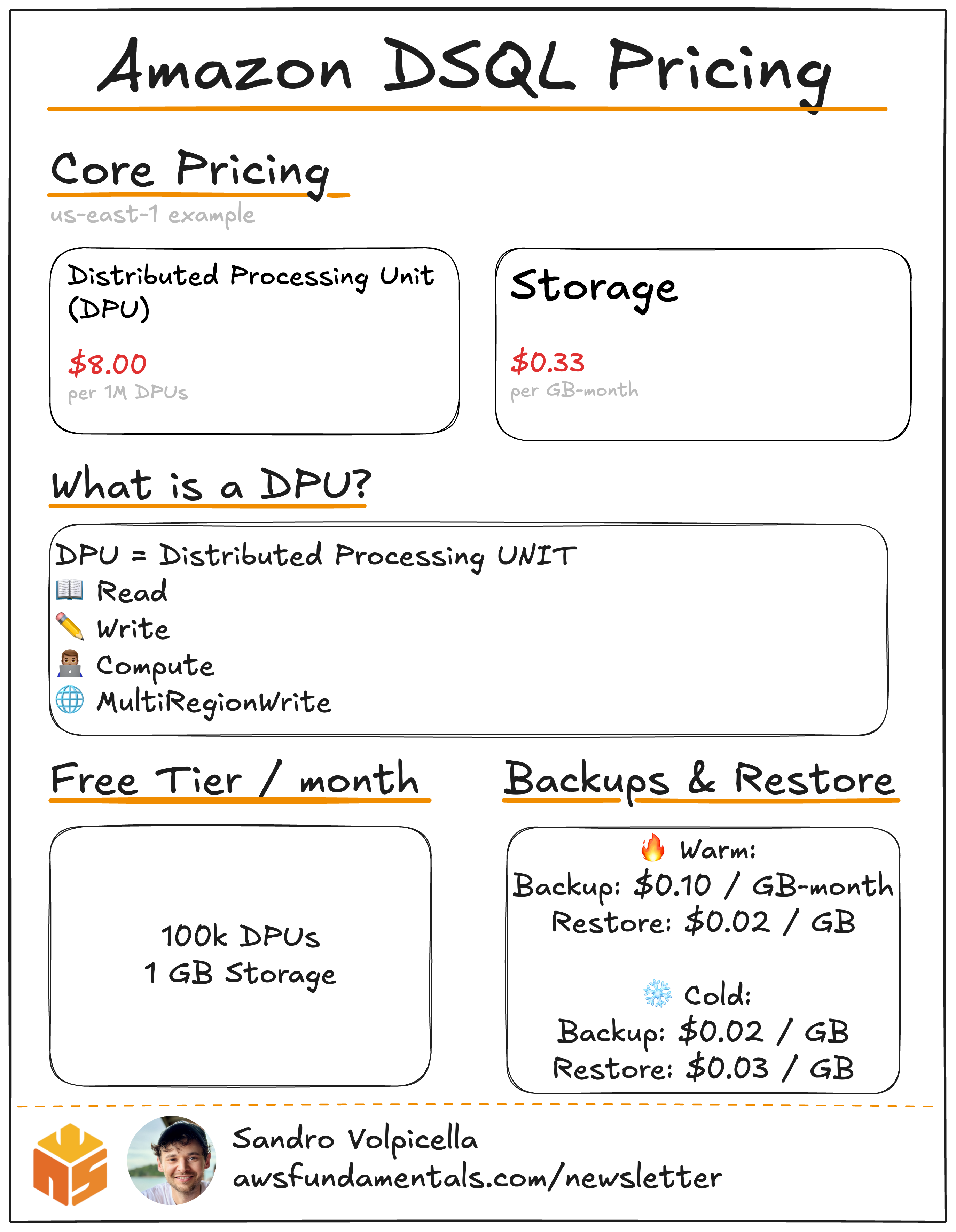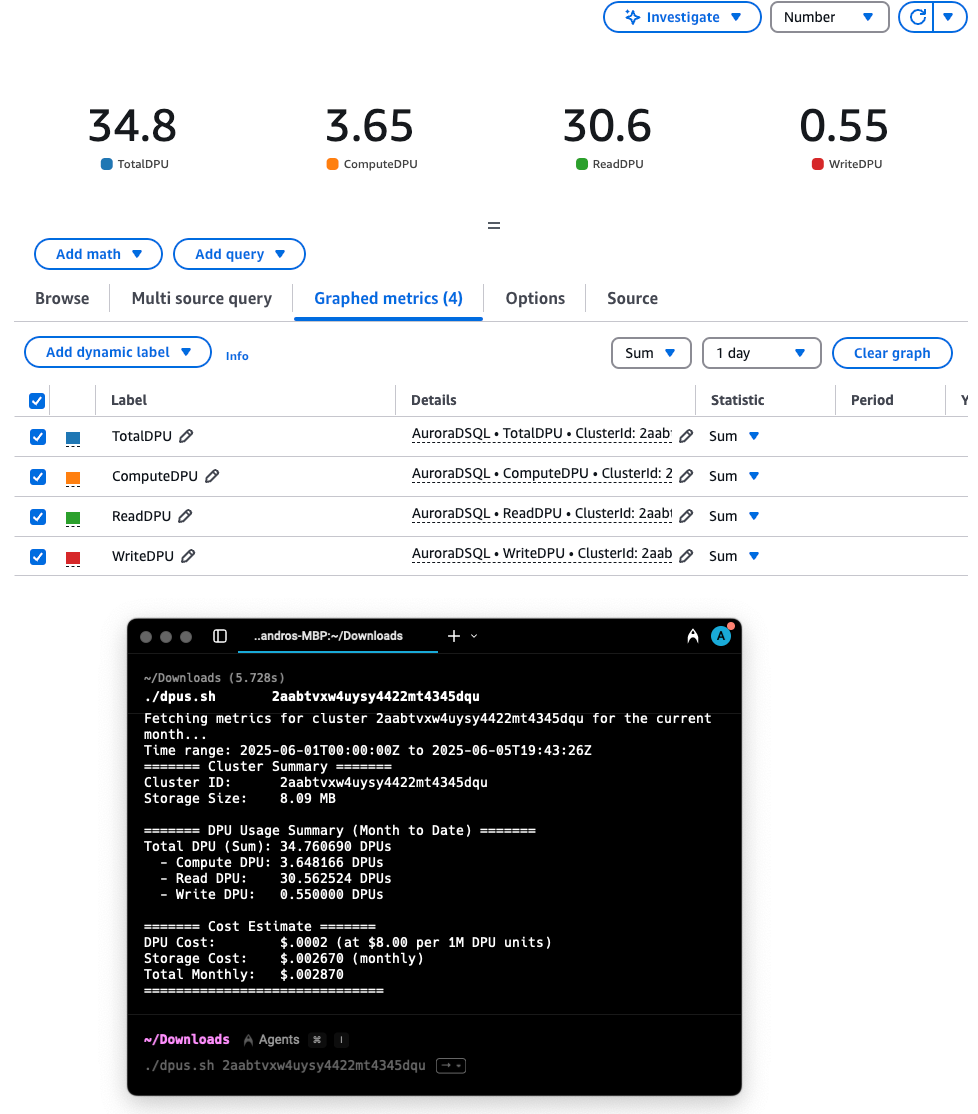New Serverless SQL on AWS — Aurora DSQL Pricing Explained
AWS FOR THE REAL WORLD
⏱️
Reading time: 6 minutes
🎯
Main Learning: Understanding Amazon Aurora DSQL pricing structure including DPUs, storage costs, and free tier
Hey Reader 👋🏽
in December 2024 AWS announced the preview of the serverless database DSQL and just in May it was generally available. With the announcement of the general availability, the pricing was also announced. The pricing is not super straightforward, so let's dive into it. IntroductionThe day has come. This time from AWS itself. Amazon Aurora DSQL claims to be the fastest serverless distributed SQL database. We're already using it for a small internal application. But AWS did something unique this time: they didn't announce any pricing with the beta launch. Let's take a look at what AWS came up with and how much it will cost to run some example workloads. Here's a first overview of the pricing: 
Pricing DefinitionsThe main selling point of this database is that AWS claims (again) that it's fully serverless. Of course, AWS has introduced some new units we need to learn about first. DPU = Distributed Processing Unit.
Storage, on the other hand, is based on total GB per month. What this shows us is that even though there are no upfront costs, there will still be costs even if you don't have any reads or writes, because you still pay for storage. This makes sense. In US East 1 (us-east-1), for example, the costs are:
What is a Distributed Processing Unit (DPU)On the pricing page of DSQL, a DPU is defined as:
This means the pricing is pretty similar to DynamoDB. We can calculate this using CloudWatch, since the metrics are available there:
The total of these will be your total DPU usage. Unfortunately, this is the most detailed definition I can provide for what a DPU is. Estimating the price of a migration or of an application isn't really straightforward yet. How much does our application cost?Like I said, we have an example application running. To calculate this, first copy your cluster ID from the Aurora DSQL console.
I know that's quite a few steps, but this will show you the total DPU and the breakdown. Marc Bowes (one of the key engineers behind DSQL) also published a handy script for that here. 
Our application currently costs $0.00287 per month. Free Tier
AWS also offers a generous free tier for this database. Data TransferThe one thing everyone tends to forget: Data Transfer costs. Backup and Restore CostsOne thing you need with every storage service is backups. AWS differentiates between Warm and Cold backups. Some example costs of backups for US East 1 (us-east-1) are:
To be honest, there isn't much defined about what warm and cold backups actually are in DSQL. But in general, the backup strategies are defined as:
Typically, you mix and match both of them. SummaryI hope this gives you some clarity on DSQL pricing. Unfortunately, understanding and estimating how many DPUs our applications need is not possible right now (at least for us). Having a SQL database at hand with purely usage-based pricing is simply amazing. Resources |
AWS for the Real World
We teach AWS for the real world - not for certifications. Join more than 10,500 developers learning how to build real-world applications on AWS.
AWS FOR THE REAL WORLD ⏱️ Reading time: 10 minutes 🎯 Main Learning: Building and testing Lambda@Edge functions with CloudFront is complicated, as deployments can take up to 10 minutes. With LocalStack, you can build, test, and debug your Lambda@Edge functions locally! 📝 Blog Post 💻 GitHub Repository 🎬 Watch on YouTube Hey Reader 👋🏽 Happy new year! We hope you had a great time with your families and loved ones 😊 We took some time off. Sandro is bridging the cold winter in Thailand (say hi if...
AWS FOR THE REAL WORLD ⏱️ Reading time: 7 minutes 🎯 Main Learning: Learn how to securely connect to your RDS database in a private subnet using an EC2 jumphost and AWS Session Manager. No SSH keys needed. 📝 Blog Post 💻 GitHub Repository 🎬 Watch on YouTube Hey Reader 👋🏽 Hope you had a great Christmas with your loved ones 🎄 Tobi and I spent a few days in Berlin consulting with a startup, then caught the last sunny days in Munich before winter really hits. This week: how to actually connect to...
AWS FOR THE REAL WORLD ⏱️ Reading time: 6 minutes 🎯 Main Learning: Build a central alerting approach with CloudWatch, Lambda, EventBridge, and CDK across your AWS Organization. 📝 Blog Post 💻 GitHub Repository 🎬 Watch on YouTube Hey Reader 👋🏽 Welcome to the first issue after re:Invent. For everybody who was out there, I hope you came home safe & healthy. I heard re:Invent cold is a thing like Oktoberfest cold in Munich 🍻 📰 This Week in AWS ⏸️AWS Lambda Durable Functions Lambda launched Durable...
